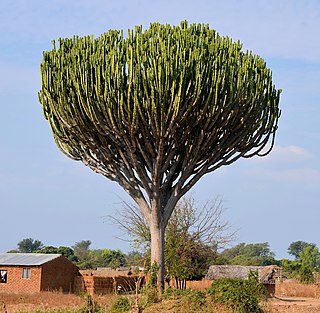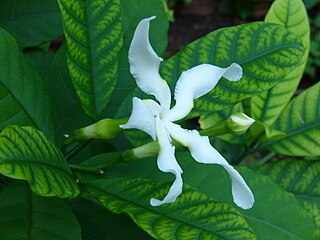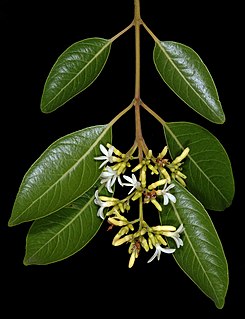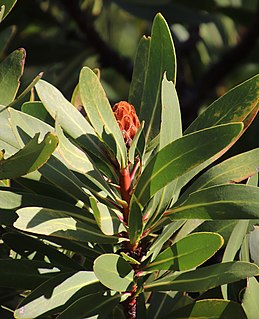
Acacia pycnantha, most commonly known as the golden wattle, is a tree of the family Fabaceae native to southeastern Australia. It grows to a height of 8 m (26 ft) and has phyllodes instead of true leaves. Sickle-shaped, these are between 9 and 15 cm long, and 1–3.5 cm wide. The profuse fragrant, golden flowers appear in late winter and spring, followed by long seed pods. Plants are cross-pollinated by several species of honeyeater and thornbill, which visit nectaries on the phyllodes and brush against flowers, transferring pollen between them. An understorey plant in eucalyptus forest, it is found from southern New South Wales and the Australian Capital Territory, through Victoria and into southeastern South Australia.

Protea comptonii, also known as saddleback sugarbush, is a smallish tree of the genus Protea in the family Proteaceae. It is found in South Africa and Eswatini.

Euphorbia ingens is a species of flowering plant in the family Euphorbiaceae. It is native to dry areas of southern Africa. It is popularly known as the candelabra tree or naboom, and its milky latex can be extremely poisonous, and a dangerous irritant.

Homalanthus populifolius, the bleeding heart, native poplar or Queensland poplar, is an Australian rainforest plant in the family Euphorbiaceae. It often appears in areas of rainforest disturbance. Bleeding heart is highly regarded by rainforest regenerators because of its fast growth and use as a pioneer species in rainforest regeneration.

Strophanthus hispidus, the hispid strophanthus, is a liana or shrub that can grow up to 5 metres (16 ft) tall. Its flowers feature a yellow corolla and yellow corona lobes spotted with red, purple or brown. The seeds, like those of several other Strophanthus species, contain potent cardiac glycosides absorbable through wounds - hence its use in African arrow poisons and later in modern medicine as a digitalis-like heart stimulant. Strophanthus hispidus is native from west tropical Africa east to Tanzania and south to Angola. It is naturalized in China.
Hunteria umbellata grows as either a shrub or small tree up to 22 metres (72 ft) tall, with a trunk diameter of up to 40 centimetres (16 in). Its flowers feature a white, creamy or pale yellow corolla. The fruit is yellow and smooth. Its habitat is forests from sea level to 600 metres (2,000 ft) altitude. Its numerous local medicinal uses include for fever, leprosy sores, stomach and liver problems and as an anthelmintic, especially against internal worms. Hunteria umbellata has been used as arrow poison. The plant's hard wood is used in carving and to make small tools. The species is native to an area of tropical Africa from Guinea-Bissau in the west to Angola in the south.
Hunteria zeylanica grows as either an evergreen shrub or as a tree up to 15 metres (49 ft) tall, with a trunk diameter of up to 34.5 centimetres (13.6 in). Its flowers feature a white corolla. The berries are yellow. Its habitat is forests from sea level to 350 metres (1,150 ft) altitude. The trees can withstand salinity. Local medicinal uses include for stomach-ache. Hunteria zeylanica wood is used for weapon handles and as firewood. In Africa, the plant is native to Kenya and Tanzania and in Asia it is native to China, India, Sri Lanka, Indochina and western Malesia.

Rauvolfia mannii grows as a shrub or small tree up to 8 metres (26 ft) tall. Its fragrant flowers feature white to pink or red-brown, or yellow corolla lobes. Its habitat is forests from sea level to 2,500 metres (8,200 ft) altitude. The plant has been used as arrow poison. Rauvolfia mannii is native to central Africa.

Tabernaemontana crassa is a plant in the dogbane family Apocynaceae, native to tropical Africa.

Tabernaemontana pachysiphon grows as a shrub or small tree up to 15 metres (50 ft) tall, with a trunk diameter of up to 40 centimetres (16 in). Its fragrant flowers feature white to pale yellow corolla lobes. The fruit is green, almost spherical, up to 15 centimetres (6 in) in diameter. Its habitat is forests from sea level to 2,200 metres (7,200 ft) altitude. Its numerous local medicinal uses include as a styptic, and as a treatment for headache, hypertension and to relieve cramps. The species is native to tropical Africa.

Tabernaemontana ventricosa is a plant in the family Apocynaceae. It grows as a shrub or small tree up to 15 metres (50 ft) tall, with a trunk diameter of up to 30 centimetres (12 in) and has white sap. Leaves are paired and crowded near the ends of branches. They are oblong, leathery and a glossy dark green. Flowers are fragrant with white, somewhat twisted lobes, often with a pale yellow center and are set in small clusters at the ends of branches. The fruit is dark green, set in spreading pairs of ellipsoids or oval, beaked pods, up to 10 centimetres (4 in) in diameter. Its habitat is forests from sea level to 1,850 metres (6,000 ft) altitude. In Zimbabwe, it is usually found as part of the understorey of evergreen forests. Local medicinal uses include the treatment of wounds, fever and hypertension. The plant is native to tropical central and southern Africa.
Tabernaemontana stapfiana is a medium-sized tree in the family Apocynaceae. Its flowers feature white with yellow-throated corolla lobes. The fruit is fleshy grey-green, in pairs, each up to 20 centimetres (8 in) in diameter and weighing up to several kilograms. Its habitat is montane evergreen forests from 700–2,000 metres (2,300–6,600 ft) altitude. The plant is native to an area of Africa from Uganda south to Mozambique.

Tabernaemontana pandacaqui, known as windmill bush and banana bush, is a species of plant in the dogbane family Apocynaceae.

Diplorhynchus is a monotypic genus of plant in the family Apocynaceae native to tropical and southern Africa. As of August 2020, Plants of the World Online recognises the single species Diplorhynchus condylocarpon.
Pleiocarpa is a genus of plant in the family Apocynaceae first described as a genus in 1876. It is native to tropical Africa from Senegal to Tanzania and south to Zimbabwe. As of August 2013 the World Checklist of Selected Plant Families recognises 6 species:
- Pleiocarpa bicarpellataStapf - Cabinda, Cameroon, Republic of Congo, Gabon, Zaire, Kenya
- Pleiocarpa brevistylaOmino - Gabon
- Pleiocarpa muticaBenth. - Ghana, Ivory Coast, Liberia, Sierra Leone, Nigeria, Cameroon, Gabon, Central African Republic, Republic of Congo
- Pleiocarpa picralimoides(Pichon) Omino - Cabinda, Republic of Congo, Gabon
- Pleiocarpa pycnantha(K.Schum) Stapf - widespread across most of tropical Africa
- Pleiocarpa rostrataBenth. - Nigeria, Cameroon, Gabon
- Pleiocarpa camerunensis(K.Schum. ex Hallier f.) Stapf = Hunteria camerunensisK.Schum. ex Hallier f.
- Pleiocarpa hockiiDe Wild. - Acokanthera oppositifolia(Lam.) Codd
- Pleiocarpa simii(Stapf) Stapf ex Hutch. & Dalziel = Hunteria simii(Stapf) H.Huber

Pleiocarpa mutica is a plant in the family Apocynaceae.
Schizozygia is a monotypic genus of plant in the family Apocynaceae found in tropical Africa and the Comoros. As of July 2020, Plants of the World Online recognises the single species Schizozygia coffaeoides.

Markhamia zanzibarica, also known as bell bean tree or maroon bell-bean, is a species of plant in the family Bignoniaceae. It is found in East Africa and Southern Africa, from Kenya to South Africa.

Protea rubropilosa, also known as the Transvaal sugarbush, escarpment sugarbush or Transvaal mountain sugarbush, is a flowering tree, that belongs to the genus Protea in the family Proteaceae. The plant only occurs in South Africa.

Protea lorifolia, in English called the strap-leaved sugarbush, strap-leaved protea or strap-leaf sugarbush is a flowering shrub which belongs to the genus Protea.















